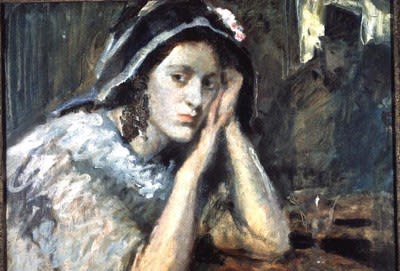
Gerald Leslie Brockhurst
Portrait of Anais, the Artist's Wife, c. 1915
Oil on canvas
20 x 24 in. (51 x 61 cm)
Philip Mould & Co.
To view all current artworks for sale visit philipmould.com Born in 1890, the son of a coal merchant, Brockhurst's artistic talent was nevertheless recognised at an early age, and he...
To view all current artworks for sale visit philipmould.com
Born in 1890, the son of a coal merchant, Brockhurst's artistic talent was nevertheless recognised at an early age, and he was awarded a scholarship at the Birmingham School of Art when he was 12 years old. There he studied for five years until he entered the Royal Academy Schools in London, achieving considerable success throughout his studies.
After finishing his artistic training Brockhurst immediately began to concentrate on figure subjects and portraits, and in September 1914 (after his marriage to Anais Folin) set off to travel throughout France and Italy. It was Brockhurst's first direct contact with the work of the Italian masters - particularly those of the quattrocento - and he was to acknowledge them as one of the few areas of influence on his art. In 1915 the couple moved to Ireland where they were to be based for five years, and whilst there Brockhurst developed a strong friendship with Augustus John. Brockhurst's contact with John had an immediate and lasting impact on his work - particularly his drawings and watercolours - and the period between 1915-20 was to prove one of the most productive as well as the most innovative of Brockhurst's career.
By 1920 Brockhurst and his wife had returned to London, and Brockhurst resumed exhibiting at the Royal Academy where he had submitted his first entry in 1915. The 1920s confirmed Brockhurst's status as an outstanding and highly successful portrait painter, and also consolidated his reputation as one of the outstanding printmakers of his generation. As the critic Richard Morphet points out, his portraits reveal a conspicuous degree of heightened psychological awareness, combined with tremendous virtuosity. Amongst his many famous sitters later on in his career were the Duchess of Windsor, Marlene Dietrich and Merle Oberon, as well as several influential Americans such as J Paul Getty and Mrs Paul Mellon - a factor which doubtless contributed to Brockhurst's decision to move permanently to the East Coast of America in 1940. Brockhurst's work is included in many major collections - both public and private - in Britain and America, and an exhibition of his paintings, drawings and etchings was held at the National Portrait Gallery, London in April/May 1987.
Born in 1890, the son of a coal merchant, Brockhurst's artistic talent was nevertheless recognised at an early age, and he was awarded a scholarship at the Birmingham School of Art when he was 12 years old. There he studied for five years until he entered the Royal Academy Schools in London, achieving considerable success throughout his studies.
After finishing his artistic training Brockhurst immediately began to concentrate on figure subjects and portraits, and in September 1914 (after his marriage to Anais Folin) set off to travel throughout France and Italy. It was Brockhurst's first direct contact with the work of the Italian masters - particularly those of the quattrocento - and he was to acknowledge them as one of the few areas of influence on his art. In 1915 the couple moved to Ireland where they were to be based for five years, and whilst there Brockhurst developed a strong friendship with Augustus John. Brockhurst's contact with John had an immediate and lasting impact on his work - particularly his drawings and watercolours - and the period between 1915-20 was to prove one of the most productive as well as the most innovative of Brockhurst's career.
By 1920 Brockhurst and his wife had returned to London, and Brockhurst resumed exhibiting at the Royal Academy where he had submitted his first entry in 1915. The 1920s confirmed Brockhurst's status as an outstanding and highly successful portrait painter, and also consolidated his reputation as one of the outstanding printmakers of his generation. As the critic Richard Morphet points out, his portraits reveal a conspicuous degree of heightened psychological awareness, combined with tremendous virtuosity. Amongst his many famous sitters later on in his career were the Duchess of Windsor, Marlene Dietrich and Merle Oberon, as well as several influential Americans such as J Paul Getty and Mrs Paul Mellon - a factor which doubtless contributed to Brockhurst's decision to move permanently to the East Coast of America in 1940. Brockhurst's work is included in many major collections - both public and private - in Britain and America, and an exhibition of his paintings, drawings and etchings was held at the National Portrait Gallery, London in April/May 1987.
Exhibitions
National Gallery 1940 - 20th Century Paintings No. 277Be the first to hear about our available artworks
* denotes required fields
We will process the personal data you have supplied in accordance with our privacy policy (available on request). You can unsubscribe or change your preferences at any time by clicking the link in our emails.